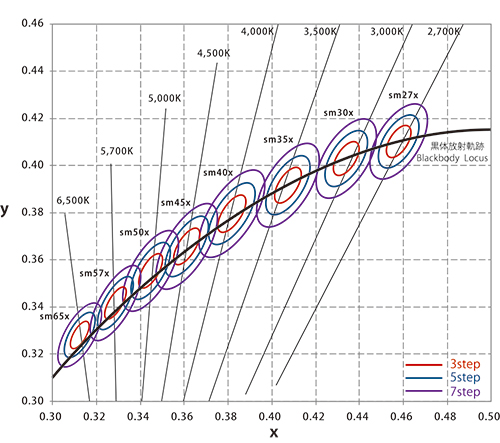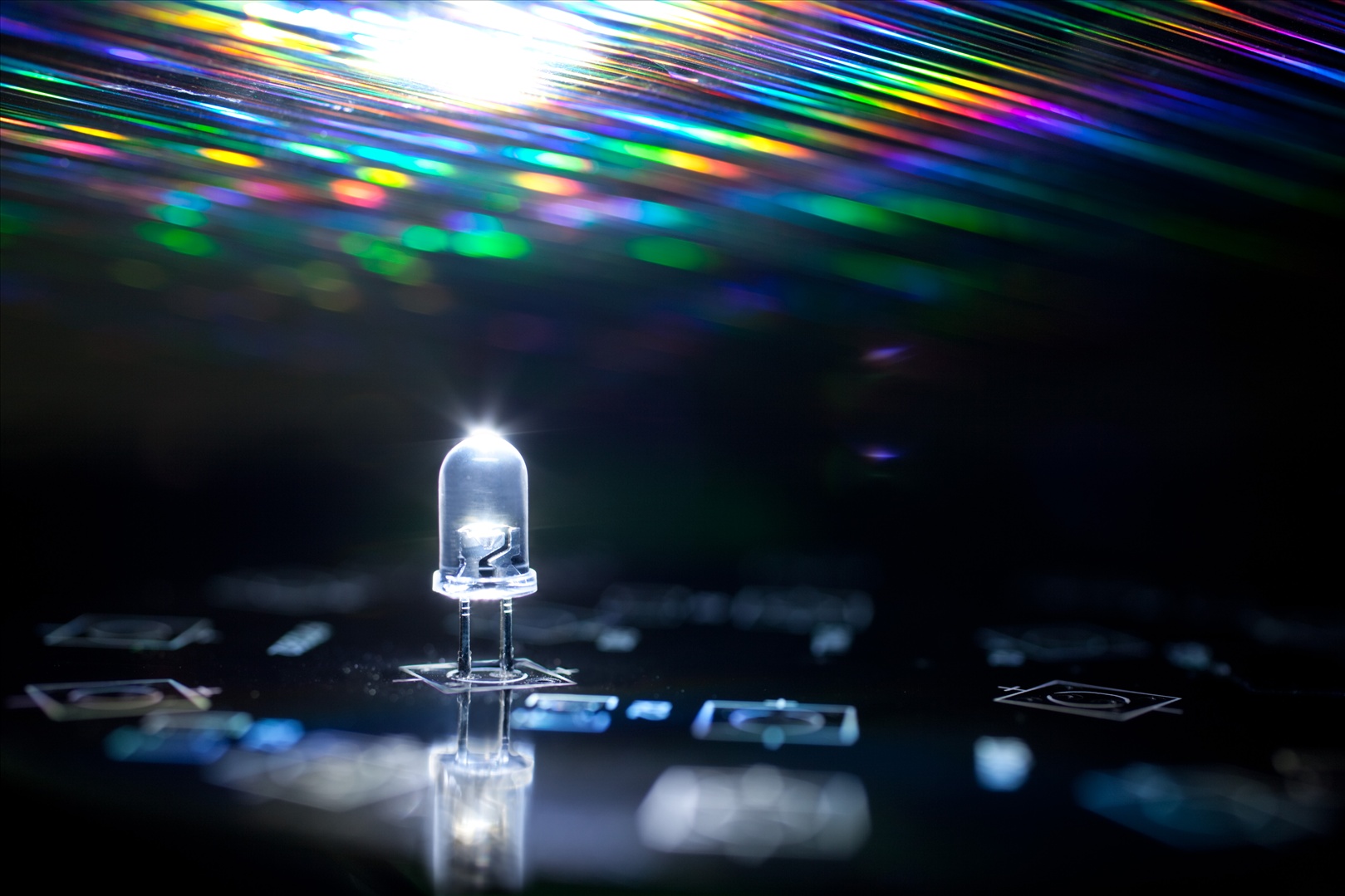White light LEDs are usually formed by two methods, the first is to use "blue technology" and phosphors to form white light, and the second is to mix multiple monochromatic lights. Both methods successfully produced white light. China's Queendom Technology uses white LEDs to develop reading lights for aircraft, high-speed rail, and trains. For decades, the streets of many countries have used white LEDs as street lights. my country's urban traffic management lights are also replacing the early traffic order lights with white LEDs. It is foreseeable that in the near future, white LEDs will enter the home and replace the existing lighting.
The wavelength range of the visible light spectrum is 380nm to 760nm, which is the seven-color light that the human eye can perceive—red, orange, yellow, green, cyan, blue, and purple, but these seven colors of light are each a monochromatic light. . For example, the peak wavelength of red light emitted by an LED is 565 nm. There is no white light in the spectrum of visible light, because white light is not monochromatic light, but a composite light composed of multiple monochromatic lights, just as sunlight is composed of seven monochromatic lights. White light is also synthesized from the three primary colors red, green and blue. It can be seen that to make an LED emit white light, its spectral characteristics should include the entire visible spectral range. But to manufacture LEDs of this performance, it is impossible under process conditions. According to people's research on visible light, the white light that the human eye can see requires at least a mixture of two kinds of light, that is, the mode of two-wavelength light emission (blue light + yellow light) or three-wavelength light (blue light + green light + red light) . Both the above-mentioned white light modes require blue light, so the absorption of blue light has become a key technology for manufacturing white light, that is, the "blue light technology" currently pursued by major LED manufacturing companies. There are only a few manufacturers who have mastered "blue light technology" in the world, so the promotion and application of white LEDs, especially the promotion of high-brightness white LEDs in my country, still has a process.
What is the wavelength range of ordinary white LED light sources?
The wavelength range of white LEDs is: 450-460nm

Comparison of spectra of various light sources.
The wavelength of visible light is in the range of 360-830NM, and the wavelength of LED light is in the range of visible light.
The light emitted by fluorescent tubes has ultraviolet rays below 360NM,
The light emitted by incandescent lamps has ultraviolet and infrared light beyond 360-830NM,
The physical properties of light include spectrum, color temperature, brightness (intensity), and light attenuation. Practice has shown that different lights have different penetrations in the air. This is actually because different light has different spectral wavelengths, and the attenuation of short-wavelength light in the air is much greater than that of long-wavelength light.
From the knowledge of optical dispersion, we know that the larger the wavelength, the smaller the frequency, so the propagation distance is limited. This is why yellow light is more penetrating than white light. By comparing the LED spectrum of normal white light, natural white light and warm white light, we will find that the lower the color temperature, the longer the band spectrum.
Spectral analysis of LED and fluorescent lamps
Fluorescent light spectrum: The light emission of fluorescent lamps is the discharge of the filament, which causes the mercury vapor to emit ultraviolet light, which stimulates the phosphorescent paint on the inner surface to release visible light of lower wavelengths. The color of the emitted light is controlled by the proportion of phosphorous components. The spectrum of fluorescent lamps is a linear spectrum, and its linear spectrum is distributed over a continuous spectrum.
LED Spectrum: Currently, most LEDs are excited by blue-chip excitation to excite one or more phosphors, and finally the light emitted by the blue and phosphors is mixed to form white light. Therefore, the spectrum of general LEDs has more than two peaks, and the relative radiant intensity of other wavelength ranges is very low. Therefore, the spectrum of the LED light source is also a linear spectrum, which is distributed on a continuous spectrum with lower radiation intensity.
As can be seen from the above, the spectrum of fluorescent lamps and LEDs has a peak linear spectrum on a continuous spectrum basis, which is different from the full spectrum of sunlight and incandescent lamps.
Effects of different spectra on the human eye
We know that the light perception of the human eye has such an inductive change: the light perception of the human eye is related to the wavelength of light. Under the condition of sufficient light (photopic vision), the human eye is most sensitive to yellow-green light around 550nm, while under the condition of weak illumination (spoon vision), it is most sensitive to blue-green light around 510nm, and the visual sensitivity function is shifted to the left shift.
We can explain the visual acuity function this way: There are three types of cone cells in the human eye, which are sensitive to red, green, and blue light. Depending on the degree of light stimulation of the three photosensitive cells, various color perceptions are produced. The superposition of the three curves is the photopic acuity curve. The human eye is far less sensitive to blue light than red and green light.
While full-spectrum sunlight and incandescent lamps have high color rendering, they actually contain many spectrums that are indistinguishable and harmful to the human eye. A high-quality light source needs to protect the eyesight of the human eye. According to the law of the relative visual acuity curve, the spectrum that is indistinguishable and harmful to the human eye can be filtered out. Assume that the light source used emits only the three spectral lines the human eye is most sensitive to, namely: blue, green and red. This seems to satisfy the human eye's need for illumination, while preventing the human eye from failing to detect harmful rays that affect the human eye's vision. But this assumes that the color rendering of the light source will be poor. Therefore, to guarantee color rendering, our ideal light source still needs a continuous background spectrum. Therefore, only from the perspective of protecting eyesight, the spectrum of fluorescent lamps and LEDs has a peak linear spectrum based on a continuous spectrum, which is more beneficial to human vision than full-spectrum sunlight and incandescent lamps.
It is worth mentioning that there is a hidden danger in the spectrum of fluorescent lamps: when the lighting time of fluorescent lamps increases, the aging of fluorescent substances occurs. At this time, the short-wave ultraviolet rays generated by the low-pressure mercury vapor discharge will be transmitted, which will damage the eyesight of the human body. So, in the long run, the LED spectrum is better for vision than fluorescent lights.
Functions and Features of LED Grow Lights
The growth law of plants must require sunlight, and LED light is a kind of light that uses artificial light instead of sunlight to provide the necessary light environment for plant growth and development. The LED light is a piece of electroluminescent semiconductor material chip, which is cured on the bracket with silver glue or white glue, and then the chip and the circuit board are connected with silver or gold wire, and sealed with epoxy resin to protect the inner core wire. The function is complete, and the housing is installed at the end, so that the LED light has good shock resistance. LEDs can directly emit red, yellow, blue, green, cyan, orange, violet and white light. In addition, LED lights are environmentally friendly and do not contain harmful substances such as mercury.
The assembled parts of the LED bulb can be easily disassembled and can be recycled by others without recycling. No flicker. The pure DC operation eliminates the visual fatigue caused by the stroboscopic of traditional light sources. Reduce line loss and do not pollute the power grid. Power factor ≥ 0.95, harmonic distortion ≤ 20%, EMI conforms to the global index, reduces the power loss of the power supply line, and avoids high-frequency interference and pollution to the power grid. LED lamp technology is changing with each passing day, its luminous efficiency is making amazing breakthroughs, and the price is also falling.
The era of white LEDs entering the home is rapidly approaching. Impact resistance, strong lightning strike resistance, no ultraviolet (UV) and infrared (IR) radiation. There is no filament and glass shell, no broken problems of traditional lamps, no harm to the human body, and no radiation. Therefore, it promotes the growth of plants at night or in dark conditions. LED lights used in the field of plant cultivation also have the following characteristics: rich in wavelength types, consistent with the spectral scale of plant photosynthesis and light morphogenesis; spectral bandwidth is narrow, and pure monochromatic light and composite spectrum can be obtained as required. LED Lights Light of a specific wavelength can be concentrated on the crops and illuminated evenly.
LED grow lights can not only regulate the flowering and fruiting of crops, but also control the height and nutrients of the plants. The system has the advantages of less heat and less space, and a multi-layer cultivation plane combination system can be used to achieve low heat load and miniaturization of production space. In addition, the extreme durability of LED lights also reduces operating costs. Because of these obvious properties, LED lights are ideal for growing in a controlled environment. The different spectral components of LED lights have a significant impact on plant tissue culture, equipment gardening and plant seedling breeding, aerospace ecological life support systems, etc.
The entry iscreated, edited andmaintained by Guangdong QueendomTechnology. If you find thatthe contentof the entry is suspected of infringement,pleasecontact us via E-mail:gm@cn-led.net, and we will deal with it in a timelymanner in accordancewith relevant laws and regulations.Without permission,commercial websites,etc. are prohibited fromcopying and grabbing the contents of Toutiao Encyclopedia;reasonable users,copyright cooperationE-mail: as@china66.net pleaseindicate thesource from www.china66.net .Feedback 2021 china66.net
